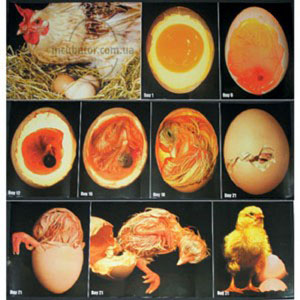Features of incubation of goose and duck eggs
Cooling mode: dry – air. One has to open the incubator two times a day for 10 minutes in the morning and evening.
Geese: 2 – 30 / day
Ducks 2 – 14 / day
Since day 15 to 28 days dry cooling shouldn’t be held for ducks.
Cooling mode: wet. Remove the cover of the incubator; sprinkle the eggs with water at room temperature, not taking them out of the incubator. Close the lid of the incubator in 5 minutes after spraying.
Geese: 7 – 14 days ……… once a day
15 – 26 days ……… twice a day
27 – 30 days ……… every 4 hours (3 – 4 times a day)
Ducks: 3 – 14 days ……….. once a day
15 – 28 days ………. two times a day – just wet.
Total time combined (wet and dry) mode – up to 15 minutes.
Mode of air (ventilation)
After 2 days of incubation – open one red cap with small diameter (for all species).
For geese and ducks from 15 days – open the two plugs of small diameter.
During the mass pipping and brood – open all three plugs.
Selection of Eggs for Incubation
Incubation success depends on the quality of eggs.
Before laying eggs in an incubator or under a hen, you must adhere to certain rules, as not suitable for every egg incubation.
Eggs from nests should be removed within one to two hours after laying, and in the cold period of time – every half an hour.
The first two eggs laid by goose are usually infertile. But taking them out of the nest is not recommended because goose can leave it.
After laying, an egg cools and its content is compressed. An air chamber forms at the large end of the egg and thereby generates a different pressure inside and outside the egg.
If the nest is dirty, then dirty air with germs and mold spores come through the shell pores, which can cause damage to the eggs and the death of the embryo during incubation.
Therefore, bedding in the nests must be often changed and disinfected.
To prevent the penetration of germs into the egg, one should disinfect eggs with an antiseptic solution “Brovadez-plus” during the first two hours after the demolition, by dipping into the solution and not wiping.
Eggs should be stored at a temperature of +10 … 150 C.
Duck eggs should be stored in an inclined or vertical position, with the sharp end down. Goose eggs should be kept horizontally, turning them once a day for 900 (quarter of the egg).
During storage, the egg is aging and there are irreversible qualitative changes that reduce hatchability.
In the first days of storage aging eggs is slow, but then rapidly increases and the percentage of chicks hatchability is being lowered.
Without compromising on quality, you can store the eggs after laying no more than:
6 days – chicken and turkey;
8 days – duck;
10 days – goose.
In the first place, for the incubation, the eggs are selected according to their appearance: clean, regular shape, the same average. Small and large eggs are not recommended to be laid.
The shells of the eggs should not have the so called “marble spots”, which speaks of the uneven thickness of the calcium and shell.
Selected by their appearance eggs are to be checked by ovoskope, a device for radiographic egg control and determining their quality.
Ovoskoping before incubation can discard up to 10% of the eggs from which chicks will not goggle. These are egg with enlarged air chamber (old eggs), eggs with microcracks of the shell, eggs “krasyuks” – with the yolk membrane rupture or “tumaks” – with the dark areas under the shell of an egg or completely darkened because of mold.
The shell must be uniformly translucent; air chamber should be small and locate on the large end of, or be slightly shifted to the side of the egg. Protein is transparent, without impurities. Yolk must be in the center of the egg and it can shift a little from one side to another from its original position while being tested by the ovoskope.
Incubating eggs should be preferably viewed by ovoskope 2-3 times from the start of the laying.
– The first time on 8 … 10 days;
– The second time on 12 … 14 days;
– The third time on 18 … 27 days. (The first number is for chicken, the other is for geese).
Poor quality eggs should be removed from the incubator, thus reducing the likelihood of bacterial contamination of eggs and making the percentage of hatchability higher.
Stages of Development of the Embryo in the Egg



